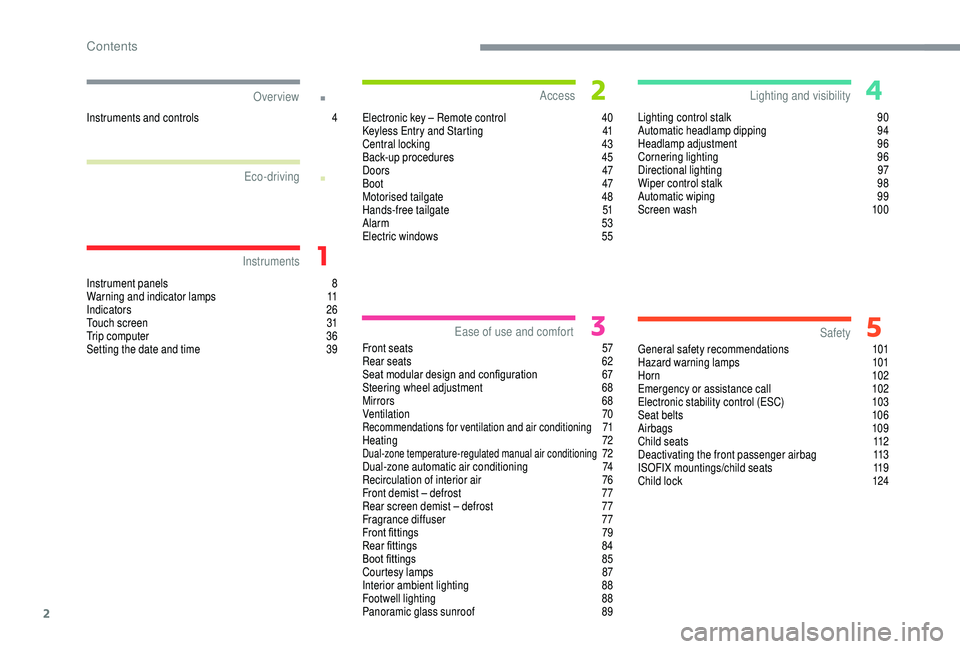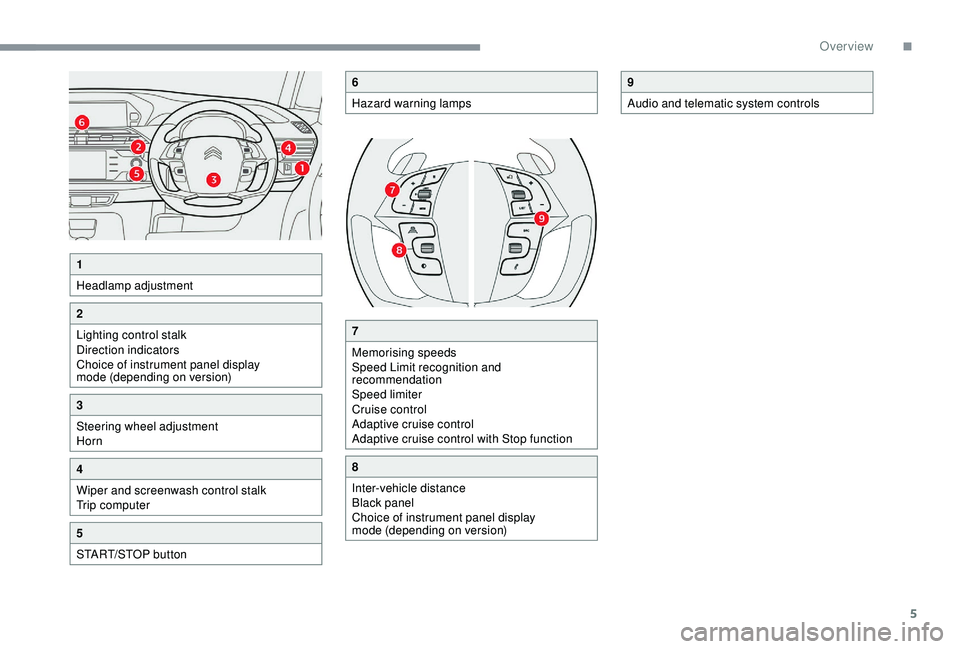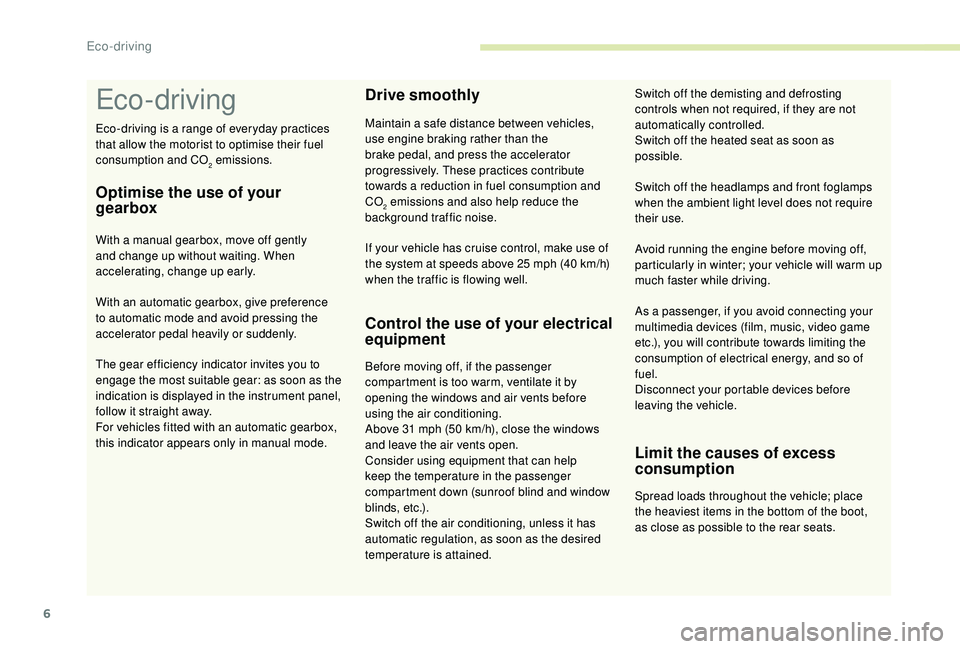headlamp CITROEN C4 PICASSO 2020 Owners Manual
[x] Cancel search | Manufacturer: CITROEN, Model Year: 2020, Model line: C4 PICASSO, Model: CITROEN C4 PICASSO 2020Pages: 316, PDF Size: 10.36 MB
Page 4 of 316

2
.
.
Instrument panels 8
W arning and indicator lamps 1 1
Indicators
26
Touch screen
3
1
Trip computer
3
6
Setting the date and time
3
9
Instruments and controls
4 E
lectronic key – Remote control
4
0
Keyless Entry and Starting
4
1
Central locking
43
Ba
ck-up procedures
4
5
Doors
47
Boot
47
Motorised tailgate
4
8
Hands-free tailgate
5
1
Alarm
53
Electric windows
5
5
Front seats
5
7
Rear seats
62
S
eat modular design and configuration
6
7
Steering wheel adjustment
6
8
Mirrors
68
Ventilation
70
Recommendations for ventilation and air conditioning 71
H
eating 72
Dual-zone temperature-regulated manual air conditioning 72
D
ual-zone automatic air conditioning 7 4
Recirculation of interior air
7
6
Front demist – defrost
7
7
Rear screen demist – defrost
7
7
Fragrance diffuser
7
7
Front fittings
7
9
Rear fittings
8
4
Boot fittings
8
5
Courtesy lamps
87
In
terior ambient lighting
8
8
Footwell lighting
8
8
Panoramic glass sunroof
8
9 Lighting control stalk
9
0
Automatic headlamp dipping
9
4
Headlamp adjustment
9
6
Cornering lighting
9
6
Directional lighting
9
7
Wiper control stalk
9
8
Automatic wiping
9
9
Screen wash
1
00
General safety recommendations
1
01
Hazard warning lamps
1
01
Horn
102
Emergency or assistance call
1
02
Electronic stability control (ESC)
1
03
Seat belts
1
06
Airbags
109
Child seats 1 12
Deactivating the front passenger airbag 1 13
ISOFIX mountings/child seats 1
19
Child lock
1
24
Over view
Instruments Access
Ease of use and comfort Safety
Lighting and visibility
Eco-driving
Contents
Page 7 of 316

5
7
Memorising speeds
Speed Limit recognition and
recommendation
Speed limiter
Cruise control
Adaptive cruise control
Adaptive cruise control with Stop function
8
Inter-vehicle distance
Black panel
Choice of instrument panel display
mode (depending on version)
9
Audio and telematic system controls
1
Headlamp adjustment
2
Lighting control stalk
Direction indicators
Choice of instrument panel display
mode (depending on version)
3
Steering wheel adjustment
Horn
4
Wiper and screenwash control stalk
Trip computer
5
START/STOP button
6
Hazard warning lamps
.
Over view
Page 8 of 316

6
Eco- driving
Eco-driving is a range of everyday practices
t hat allow the motorist to optimise their fuel
consumption and CO
2 emissions.
Optimise the use of your
gearbox
With a manual gearbox, move off gently
a nd change up without waiting. When
accelerating, change up early.
With an automatic gearbox, give preference
to automatic mode and avoid pressing the
accelerator pedal heavily or suddenly.
The gear efficiency indicator invites you to
engage the most suitable gear: as soon as the
indication is displayed in the instrument panel,
follow it straight away.
For vehicles fitted with an automatic gearbox,
this indicator appears only in manual mode.
Drive smoothly
Maintain a safe distance between vehicles,
u se engine braking rather than the
brake pedal, and press the accelerator
progressively. These practices contribute
towards a
reduction in fuel consumption and
CO
2 emissions and also help reduce the
b
ackground traffic noise.
Control the use of your electrical
equipment
Before moving off, if the passenger
compartment is too warm, ventilate it by
opening the windows and air vents before
using the air conditioning.
Above 31
mph (50 km/h), close the windows
and leave the air vents open.
Consider using equipment that can help
keep the temperature in the passenger
compartment down (sunroof blind and window
blinds, etc.).
Switch off the air conditioning, unless it has
automatic regulation, as soon as the desired
temperature is attained. Switch off the headlamps and front foglamps
when the ambient light level does not require
their use.
Avoid running the engine before moving off,
particularly in winter; your vehicle will warm up
much faster while driving.
As a
passenger, if you avoid connecting your
multimedia devices (film, music, video game
etc.), you will contribute towards limiting the
consumption of electrical energy, and so of
fuel.
Disconnect your portable devices before
leaving the vehicle.
Limit the causes of excess
consumption
Spread loads throughout the vehicle; place
the heaviest items in the bottom of the boot,
as close as possible to the rear seats.
If your vehicle has cruise control, make use of
the system at speeds above 25
mph (40
km/h)
when the traffic is flowing well. Switch off the demisting and defrosting
controls when not required, if they are not
automatically controlled.
Switch off the heated seat as soon as
possible.
Eco-driving
Page 27 of 316

25
Left-hand
direction
indicatorFlashing with audible
signal.
The direction indicators are on.
Right-hand
direction indicatorFlashing with audible
signal.The direction indicators are on.
Sidelamps Fixed. The lamps are on.
Dipped beam
headlamps Fixed.
The lamps are on.
Directional
headlamps Flashing.
The directional headlamps system
has a
fault. Have it checked by a
CITROËN dealer or a qualified
workshop.
Front foglamps Fixed. The front foglamps are on.
Automatic
wiping Fixed.
Automatic windscreen wiping is
activated.
+
or Automatic
headlamp
dipping
Fixed.
The function has been activated in
the touch screen (Driving m e n u).
The lighting control stalk is in the
"AUTO" position.
Blue warning/indicator lamps
Main beam
headlamps Fixed.
The main beams are on.
Warning/indicator lamp
StateCause Actions/Observations
1
Instruments
Page 35 of 316

33
Driving menu
Vehicle settings tab
FamiliesFunctions with CITROËN Connect Radio Functions with CITROËN Connect Nav
Driving lighting -
"
Guide-me-home lighting": activation/deactivation of
automatic guide-me-home lighting.
-
"
Welcome lighting": activation/deactivation of exterior
welcome lighting.
-
"
Directional headlamps": activation/deactivation of the
cornering lighting/directional headlamps.
-
"Daytime running lamps" (LED daytime running lamps)
depending on country of sale.
- "Directional headlamps": activation/deactivation of the cornering lighting/directional headlamps.
-
"Daytime running lamps" (LED daytime running lamps)
depending on country of sale.
Vehicle access - " Unlock driver's door only": activation/deactivation of
selective unlocking of the driver's door.
-
"
Unlock boot only": activation/deactivation of unlocking
at the tailgate.
-
"
Motorised tailgate": activation/deactivation of
motorised operation of the tailgate.
-
"
Hands-Free Tailgate Access": activation/deactivation
of the hands-free tailgate function. -
" Unlock driver's door only": activation/deactivation of
selective unlocking of the driver's door.
-
"
Unlock boot only": activation/deactivation of unlocking
at the tailgate.
-
"
Motorised tailgate": activation/deactivation of
motorised operation of the tailgate.
-
"
Hands-Free Tailgate Access": activation/deactivation
of the hands-free tailgate function.
The functions are grouped into 4
families.
1
Instruments
Page 37 of 316

35
Driving functions tab
FunctionComment
Adjusting Speeds Memorisation of speed settings for the speed limiter, cruise control and adaptive cruise control.
Under-inflation initialisationReinitialisation of the under-inflation system.
Diagnostic List of current alerts.
Lane assist Activation/deactivation of the "active lane departure warning" system.
Parking sensors Activation/deactivation of the function.
Automatic headlamp dipping Activation/deactivation of the "automatic headlamp dipping" function.
Stop & Star t Activation/deactivation of the function.
Blind spot sensors Activation/deactivation of the function.
Panoramic visual aid Activation/deactivation of the function and then choice of options.
Active cruise control Choice of the standard cruise control or adaptive cruise control function.
Traction control Activation/deactivation of the function.
For more information on one of these
functions, refer to the corresponding
section.
1
Instruments
Page 71 of 316

69
Automatic tilting in reverse gear
System which provides a view of the ground
d uring parking manoeuvres in reverse gear.
They return to their initial position:
- a f ew seconds after coming out of reverse gear,
-
o
nce the speed of the vehicle exceeds 6 mph
(10
km/h),
-
o
n switching off the engine.
This function can be activated/deactivated in
the Driving menu of the touch screen.
F
Sel
ect the " Vehicle settings " tab, then
" Comfort " and "Mirror adaptation in
reverse ".
Rear view mirror
Equipped with an anti-dazzle system, which
darkens the mirror glass and reduces the
nuisance to the driver caused by the sun,
headlamps from other vehicles, etc.
Manual model
Adjustment
F
A djust the mirror so that the glass is
directed correctly in the "day" position. F
P
ush the lever to change to the normal
"day" position.
Automatic "electrochrome " model
This system automatically and progressively
changes between day and night use by means
of a
s
ensor measuring the light coming from the
rear of the vehicle.
In order to ensure optimum visibility during
your manoeuvres, the mirror lightens
automatically when reverse gear is
engaged.
Child surveillance mirror
If the mirrors are folded using control A ,
they will not unfold when the vehicle is
unlocked. Pull again on control A .
Unfolding
F From outside: unlock the vehicle using the
electronic key or the " K eyless Entry and
Starting" system.
F
F
rom inside: with the ignition on, pull
the control A from the central position
rearwards.
The folding and unfolding of the door
mirrors using the remote control can be
deactivated by a
CITROËN dealer or
a
qualified workshop.
If necessary, the mirrors can be folded
manually.
With the engine running, on engaging reverse
gear, the mirror glasses tilt downwards.
Day/night position
F P ull the lever to change to the "night" anti-
dazzle position.
3
Ease of use and comfort
Page 92 of 316

90
Lighting control stalk
In some weather conditions (e.g. low
temperature or humidity), the presence
of misting on the internal sur face of the
glass of the headlamps and rear lamps is
normal; it disappears after the lamps have
been on for a few minutes.
If one or more lamps fails, a message
asks you to check the lamp or lamps
concerned.
Driving abroad
Halogen headlamps
If planning to use your vehicle in a
country
that drives on the other side of the road,
the dipped beam headlamps must be
adjusted to avoid dazzling on-coming
drivers. Contact a
CITROËN dealer or
qualified workshop.
Xenon headlamps
The design of the dipped beam headlamps
allows, without modification, driving in
a
country that drives on the other side
of the road to the country in which your
vehicle was sold.
Main lighting
Without AUTO lighting
With AUTO lighting
Selection of main lighting mode
Turn the ring to align the desired symbol with
the marking. Lighting off (ignition off)/Daytime
running lamps (engine running). Automatic illumination of headlamps.
Daytime running lamps/Dipped
beam/Main beam.
Sidelamps.
Dipped or main beam headlamps.
Headlamp dipping
Pull the stalk towards you to switch between
dipped and main beam headlamps or to
activate automatic headlamp dipping.
In the lighting off and sidelamps modes, the
driver can switch on the main beam headlamps
temporarily ("headlamp flash"), for as long as
the stalk is kept pulled.
Displays
Illumination of the corresponding indicator
lamp in the instrument panel confirms that the
lighting selected is switched on.
Lighting and visibility
Page 93 of 316

91
Foglamps
They operate with the dipped and main beam
headlamps.
With rear foglamps only
Rear foglamps
F
T
urn the sensor ring for wards to switch on
the foglamps.
F
T
urn the sensor ring backwards to switch off
the foglamps.
If the dipped beam headlamps are
switched off manually, the rear foglamps
also switch off.
With front and rear foglamps
Front and rear foglamps
Turn and release the ring:
F
o
nce for wards to switch on the front
foglamps,
F
f
or wards a second time to switch on the rear
foglamps. If the lights are switched off automatically or
the dipped beam headlamps are switched off
manually, the foglamps and sidelamps remain
on.
F
T
urn the ring backwards to switch off the
foglamps, the sidelamps will then switch off.
Opening the tailgate prevents the
foglamps lighting up.
Opening the tailgate when the lamps are
on switches them off automatically along
with the indicator lamp in the instrument
panel. On closing the tailgate, they do not
light up automatically: it will be necessary
to use the control.
The sidelamps and the rear direction
indicators are situated on the tailgate.
During lighting, the opening of the tailgate
provokes the automatic switching of these
lamps towards the fitted lamps in the rear
bumpers to maintain the safety of the
vehicle. F
o
nce backwards to switch off the rear
foglamps,
F
b
ackwards a second time to switch off the
front foglamps.
4
Lighting and visibility
Page 94 of 316

92
In good or rainy weather, by both day
and night, the front foglamps and the
rear foglamps are prohibited. In these
situations, the power of their beams may
dazzle other drivers. They should only be
used in fog or falling snow.
In these weather conditions, it is your
responsibility to switch on the foglamps
and dipped headlamps manually as the
sunshine sensor may detect sufficient
light.
Switch off the front and rear foglamps
when they are no longer necessary.
Switching off of the lighting when the
ignition is switched off
On switching off the ignition, all of the
lighting turns off immediately, except for
dipped beam headlamps if automatic
guide-me-home lighting is activated.Switching on the lighting after the
ignition is switched off
To reactivate the lighting control stalk,
rotate ring A to the 0
position – lamps off,
then to the desired position.
On opening the driver's door a
temporary
audible signal warns the driver that the
lighting is on.
It will go off automatically after a
period of
time that depends on the state of charge
in battery (entering energy economy
m o d e).
Direction indicators (flashers)
F Left: lower the lighting control stalk passing the point of resistance.
F
R
ight: raise the lighting control stalk passing
the point of resistance.
Three flashes
F Press briefly upwards or downwards, without going beyond the point of
resistance; the direction indicators will flash
3
times.
Parking lamps
Vehicle side marking by illumination of the
sidelamps on the traffic side only.
F
D
epending on version, within one minute
of switching off the ignition, operate the
lighting control stalk up or down depending
on the traffic side (for example, when
parking on the right, push the lighting
control stalk downwards; the left-hand
sidelamps come on).
This is confirmed by an audible signal and
illumination of the corresponding direction
indicator lamp in the instrument panel.
Lighting and visibility